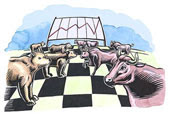 A week ago, MarketWatch featured an update on the Dow Theory, the oldest market timing system in existence. Editor Richard Russell made an announcement that he now believes that the stock market has been in a primary bull market since the early 1980s:
A week ago, MarketWatch featured an update on the Dow Theory, the oldest market timing system in existence. Editor Richard Russell made an announcement that he now believes that the stock market has been in a primary bull market since the early 1980s:
The lows of October 2002 and January 2008 therefore represent nothing more than “important secondary or cyclical correction-bottoms.”
As if he wanted to make sure there was no misunderstanding, Russell headlined his Web posting Monday night: “A Shocking Revelation: The Bull Never Left.”
What factors could lead to such a dramatic change of heart in an adviser who earlier this year had argued that we were in a primary bear market?
The first, according to Russell, is that “the major stock averages have been building huge bases,” and therefore appear ready to move much higher — to new all-time highs, in fact. The second factor is that, at the market’s low earlier this year, just as was the case at the October 2002 bottom, stocks were not even close to being as cheap as they were at the major bear market bottoms of the past.
Given these two factors, Russell says he sees “no other explanation” for what’s been going on than that we’ve been in an uninterrupted bull market since the early 1980s.
What would a major bear market bottom look like?
Don’t ask …
“Somewhere ahead we’re finally going to enter a true primary bear market, maybe one of the greatest and most tragic in history,” Russell writes. “That future bear market will end with something we haven’t seen since the 1980 to 1982 period, and I’m talking about great values in stocks. And when I say great values I’m talking about blue-chip stocks selling in single-digit price/earning ratios while at the same time providing dividend yields of 6-7-8%, the kind of yields we last saw at the lows of the early 1980s.”
How soon will the stock market recover its losses of the past six months and reach new all-time highs? Russell’s crystal ball is less clear in answering this question; he simply writes that it will happen “somewhere between 2008 and 2010.”
OK fine, so we’ve been in a bull market since 1980. You saw your portfolio drop some 50% during the bear market of 2000 – 20002, but hey, no big deal, because we were still in a long-term bull market. Knowing that, don’t you feel much better now?
It is totally irrelevant what you call this period; the fact is that it was not an uninterrupted up trend that would have justified you sitting on you bullish portfolio. While it is very easy to philosophize about it years later, as this article did, it does not address the pain and suffering most investors went through during the last bear market even if it now appears to be only a tiny blip on the radar screen.
Richard Russell calls these blips “nothing more than important secondary or cyclical correction-bottoms.” Maybe they are just that but, given the negative long lasting impact they had on most investors, they still need to be avoided at all costs.
Contact Ulli